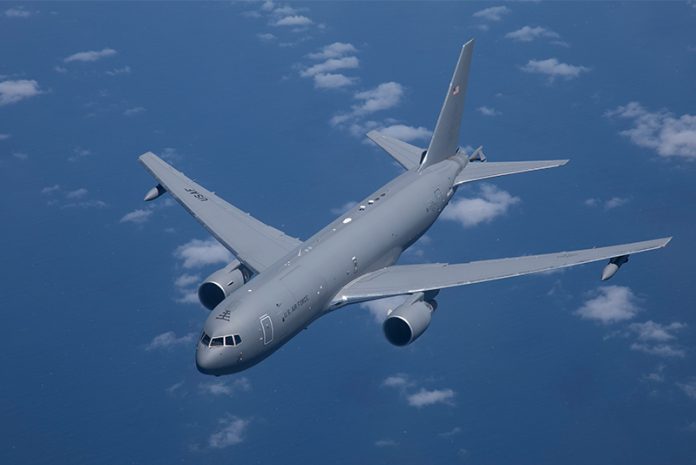Boeing and U.S Air Force teams recently achieved a major KC-46 tanker program milestone, completing all flight testing required for first delivery.
This past week, the KC-46 team concluded both its Military Type Certification testing and receiver certification testing with KC-135, F-16 and C-17 aircraft.
“This is a significant achievement for the Boeing-Air Force team and continues us on our path to first delivery in October,” said Mike Gibbons, Boeing KC-46A tanker vice president and program manager. “Great teamwork all around!”
Receiver certification, which began in April, was conducted from Boeing Field in Seattle and Edwards Air Force Base, Calif. As part of the testing, KC-46 and receiver aircraft flew at different airspeeds, altitudes and configurations to ensure compatibility and performance throughout the refueling envelope of each receiver.
Receiver certification testing of A-10 and KC-46 has also begun, with final certification of A-10, F/A-18, KC-46, F-15 and B-52 to be completed prior to the start of Initial Operational Test & Evaluation testing.
“Our main focus now is obtaining the Supplemental Type Certificate (STC) from the Federal Aviation Administration as well formal Military Type Certification (MTC) from the U.S. Air Force,” Gibbons said.
The KC-46 test team completed STC flight testing in April and is now working through associated paperwork prior to STC award.
The program has six aircraft that have supported various segments of STC and MTC testing. Overall they have completed 3,300 flight hours and offloaded two million pounds of fuel during refueling flights with F-16, F/A-18, AV-8B, C-17, A-10, KC-10 and KC-46 aircraft.
The KC-46, derived from Boeing’s commercial 767 airframe, is built in the company’s Everett, Wash., facility. Boeing is currently on contract for the first 34 of an expected 179 tankers for the U.S. Air Force.
When in service, the KC-46 will refuel U.S., allied and coalition military aircraft using its boom and hose and drogue systems, but also must be able to take on fuel to extend its operational range. The boom allows the tanker to transfer up to 1,200 gallons of fuel per minute, while the hose and drogue systems, located on both the plane’s wing and centerline, enables the KC-46 to refuel smaller aircraft with up to 400 gallons of fuel per minute.
The KC-46A is a multirole tanker that is designed to refuel all allied and coalition military aircraft compatible with international aerial refueling procedures and can carry passengers, cargo and patients.
